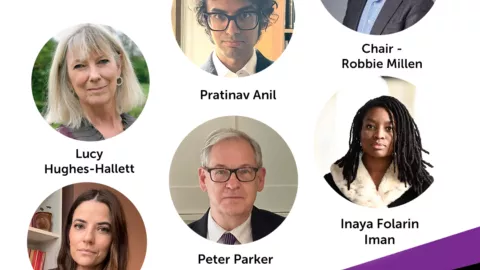
Rachel Cockerell Longlist Interview
9 October 2024
How does it feel to be longlisted?
It’s an honor and a thrill to appear on such a distinguished list. I simply cannot imagine being in better company.
How did you conduct your research?
My book covers five countries over about four decades, and every place and period required a distinct approach. My general strategy was to draw concentric circles around the four main characters. They were my guides. We spoke constantly - and in one case, daily - over a period of several years. But to do them justice I needed to range widely across (and beyond) the paths of their immediate life experiences. Researching these broader rings around them was an exercise in widening the aperture. I interviewed hundreds of other people along the way and made use of historical materials (court transcripts, government cables, immigration documents, oral-history archives, and so on).
Through the entire process, I kept four large binders of transcripts from my conversations with each of the main characters. I organized these transcripts according to the themes and chronologies of their lives. The binders became books in their own right. I read, studied, and consulted them regularly. I felt it was extremely important to keep the voices of my characters in my ears as I worked. This was an ethos as much as a reporting strategy. The idea was something like having a constant stream of conversation and personal interaction flow back and forth over every part of the research and writing process.
The closer the story came to the present, the more immediately I could rely on my own first-hand reporting and observation. Here I had done the legwork on the ground in real time, whether it was in southern Mexico, rural Guatemala, El Salvador, American cities and towns, or the US-Mexico borderlands. I wasn’t reconstructing the history here, as I had to do during the earlier sections of the book. I was narrating and collating reporting I’d done directly, whether through interviews, time in the field, or investigative work.
Can you share any moments or stories from your reporting that had a profound impact on you?
In August 2019, I traveled to a city on the Mexico-Guatemala border called Tapachula. It’s a rough, rundown place, full of migrants from all over the world who are in varying stages of desperation. Some of them were stopping over on their way to the US; others were stranded because of money problems or fears of getting arrested if they ventured any deeper into Mexican territory. I was visiting a Honduran mother and pastor named Keldy who had been separated from her children at the US border in the fall of 2017. She and I had first met in a Texas detention center, but soon after that, in 2018, the US government deported her to Honduras. She began the trip again, determined to reunite with her boys, who now lived with an aunt in Philadelphia.
That August, in Tapachula, Keldy was making plans to travel to northern Mexico. This was her destination—it was no longer the United States. If she were arrested trying to cross the border, she would spend years in prison as a felon. Her goal was to be as close to her boys as she could possibly get. That meant staying in Mexico, across the border from El Paso, Texas. At least she could physically see the country where the rest of her family lived.
I spent several days with Keldy in Tapachula, and, when I left, I flew directly to see her sons. They had a date the following week in family court, in Philadelphia. Her oldest son was petitioning a judge to take custody of his two younger siblings. In the courtroom, he had to tell the judge that his mother had abandoned them. This was a technicality. She’d obviously not abandoned them, not by choice, and everyone in the courtroom knew it. But these were the stark legal terms required to free up the custody of the younger boys. We went out for lunch afterwards, and the boys posed for photos that I could send to Keldy, who wanted to know all about the day. How had it gone? Were they in decent spirits? What did they have for lunch?
As a reporter and US citizen, I was moving freely across borders, doing something that the parent whom I was reporting on could not: I was spending time with her children. On this occasion, I was a kind of go-between and, in a certain sense, an accidental chaperone. The fundamental tragedy of all this—that I was the one who got to be there, while Keldy was stuck in Mexico—haunted me for years afterward. It was a structural fact of the journalistic situation. But that made it no easier to accept.
How do events of the 1980s and 1990s connect to the current 'immigration crisis'?
The current immigration crisis in the US is a bit of a misnomer. The US needs more immigration. The problem, in both political and policy terms, has been the asylum situation at the southern border. In recent years, more people have tried to enter the country at the border than the government can handle. Yet, by law, the US must provide legal protection to anyone fleeing persecution in his home country.
It’s impossible to make sense of the policy conundrum without understanding how we got here. In 1980, the government codified a new law that brought the US in line with the rest of the western world by creating a refugee and asylum program. At the same time, however, the US was mired in the Cold War. The first refugees to seek entry in the US under the new law were fleeing murderous regimes in Central America—regimes that the US was supporting economically, militarily, and diplomatically in its wider fight against the spread of communism in the region. In the view of officials at the State Department, admitting asylum seekers from these countries would mean acknowledging that US allies in the region were brutalizing their own people. So right from the start, this laudable aim of the 1980 Act got subverted. Those with legitimate claims for protection faced explicit discrimination. The mass rejection of asylum applications didn’t stop people from coming. It just meant that those who arrived became undocumented. All through the rest of the decade, and into the next, US policy abroad had the unintended but overwhelming effect of uprooting hundreds of thousands of people. Salvadorans and Guatemalans, in particular, fled to the US during their countries’ respective civil wars.
US domestic policy caused other international problems. The 1990s were dominated by an obsession with law and order and toughness on crime. The immigration issue slotted neatly into that political mindset. One law passed in 1996, just weeks before a presidential election, allowed the government to deport legal permanent residents based on minor crimes they’d committed many years before. There was also more to the story of the US’s relationship with Central America. Because so many vulnerable people had entered the country in the 1980s, with large numbers of them settling in inner cities like South Central Los Angeles, some were targeted by local gangs and a vicious racial hierarchy on the streets. Some Salvadorans went on to form gangs of their own, in a kind of self-defence; their identities hardened in California state prisons, which are intensely segregated based on the race of inmates. By the mid 1990s, the US deported hundreds of these Americanized gang members to Central America at a time when the governments in the region were still reeling from years of civil war. Over time, these American gangs metastasized in El Salvador, Honduras, and Guatemala. In 2014, when tens of thousands of Central American families started showing up at the US southern border seeking asylum, they were fleeing gang violence. The asylum crisis in 2014 announced a problem at the border that lawmakers have still not been able to figure out.
What do you hope readers take away from your book in terms of understanding and addressing immigration issues?
My biggest hope is that someone might read through this book and attach actual people to all the narratives, slogans, and bromides they hear daily about the immigration issue more generally. I am convinced that a tipping point exists where exposure to the true human drama can overtake callous preconceptions. In recent years, in the US and abroad, there seems to be this idea, masquerading as a kind of pragmatism, that the only way to deal with insoluble policy dilemmas is to harden our hearts against those who are suffering. Not only do I think that’s a false choice; it also gets the policy backwards.


10 April 2025

17 December 2024

19 November 2024